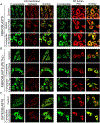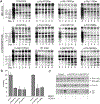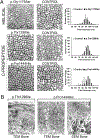COL1A1 C-propeptide mutations cause ER mislocalization of procollagen and impair C-terminal procollagen processing
- PMID: 31055083
- PMCID: PMC7521940
- DOI: 10.1016/j.bbadis.2019.04.018
COL1A1 C-propeptide mutations cause ER mislocalization of procollagen and impair C-terminal procollagen processing
Abstract
Mutations in the type I procollagen C-propeptide occur in ~6.5% of Osteogenesis Imperfecta (OI) patients. They are of special interest because this region of procollagen is involved in α chain selection and folding, but is processed prior to fibril assembly and is absent in mature collagen fibrils in tissue. We investigated the consequences of seven COL1A1 C-propeptide mutations for collagen biochemistry in comparison to three probands with classical glycine substitutions in the collagen helix near the C-propeptide and a normal control. Procollagens with C-propeptide defects showed the expected delayed chain incorporation, slow folding and overmodification. Immunofluorescence microscopy indicated that procollagen with C-propeptide defects was mislocalized to the ER lumen, in contrast to the ER membrane localization of normal procollagen and procollagen with helical substitutions. Notably, pericellular processing of procollagen with C-propeptide mutations was defective, with accumulation of pC-collagen and/or reduced production of mature collagen. In vitro cleavage assays with BMP-1 ± PCPE-1 confirmed impaired C-propeptide processing of procollagens containing mutant proα1(I) chains. Overmodified collagens were incorporated into the matrix in culture. Dermal fibrils showed alterations in average diameter and diameter variability and bone fibrils were disorganized. Altered ER-localization and reduced pericellular processing of defective C-propeptides are expected to contribute to abnormal osteoblast differentiation and matrix function, respectively.
Keywords: BMP-1; C-propeptide; Collagen processing; Endoplasmic reticulum localization; Osteogenesis imperfecta.
Copyright © 2019. Published by Elsevier B.V.
Conflict of interest statement
Disclosure statement: The authors declare no conflicts of interest.
Figures






References
-
- Marini JC (2004) Osteogenesis imperfecta In Nelson Textbook of Pediatrics (Behrman RE, Kliegman RM and Jensen HB, eds.). pp. 2336–2338, W.B. Saunders, Philadelphia.
Publication types
MeSH terms
Substances
Grants and funding
LinkOut - more resources
Full Text Sources
Miscellaneous

